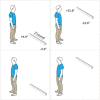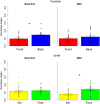Different audio spatial metric representation around the body
- PMID: 29925849
- PMCID: PMC6010478
- DOI: 10.1038/s41598-018-27370-9
Different audio spatial metric representation around the body
Abstract
Vision seems to have a pivotal role in developing spatial cognition. A recent approach, based on sensory calibration, has highlighted the role of vision in calibrating hearing in spatial tasks. It was shown that blind individuals have specific impairments during audio spatial bisection tasks. Vision is available only in the frontal space, leading to a "natural" blindness in the back. If vision is important for audio space calibration, then the auditory frontal space should be better represented than the back auditory space. In this study, we investigated this point by comparing frontal and back audio spatial metric representations. We measured precision in the spatial bisection task, for which vision seems to be fundamental to calibrate audition, in twenty-three sighted subjects. Two control tasks, a minimum audible angle and a temporal bisection were employed in order to evaluate auditory precision in the different regions considered. While no differences were observed between frontal and back space in the minimum audible angle (MAA) and temporal bisection task, a significant difference was found in the spatial bisection task, where subjects performed better in the frontal space. Our results are in agreement with the idea that vision is important in developing auditory spatial metric representation in sighted individuals.
Conflict of interest statement
The authors declare no competing interests.
Figures







References
Publication types
MeSH terms
LinkOut - more resources
Full Text Sources
Other Literature Sources

